FORD CONTOUR 1998 2.G Workshop Manual
Manufacturer: FORD, Model Year: 1998, Model line: CONTOUR, Model: FORD CONTOUR 1998 2.GPages: 200, PDF Size: 2.7 MB
Page 51 of 200
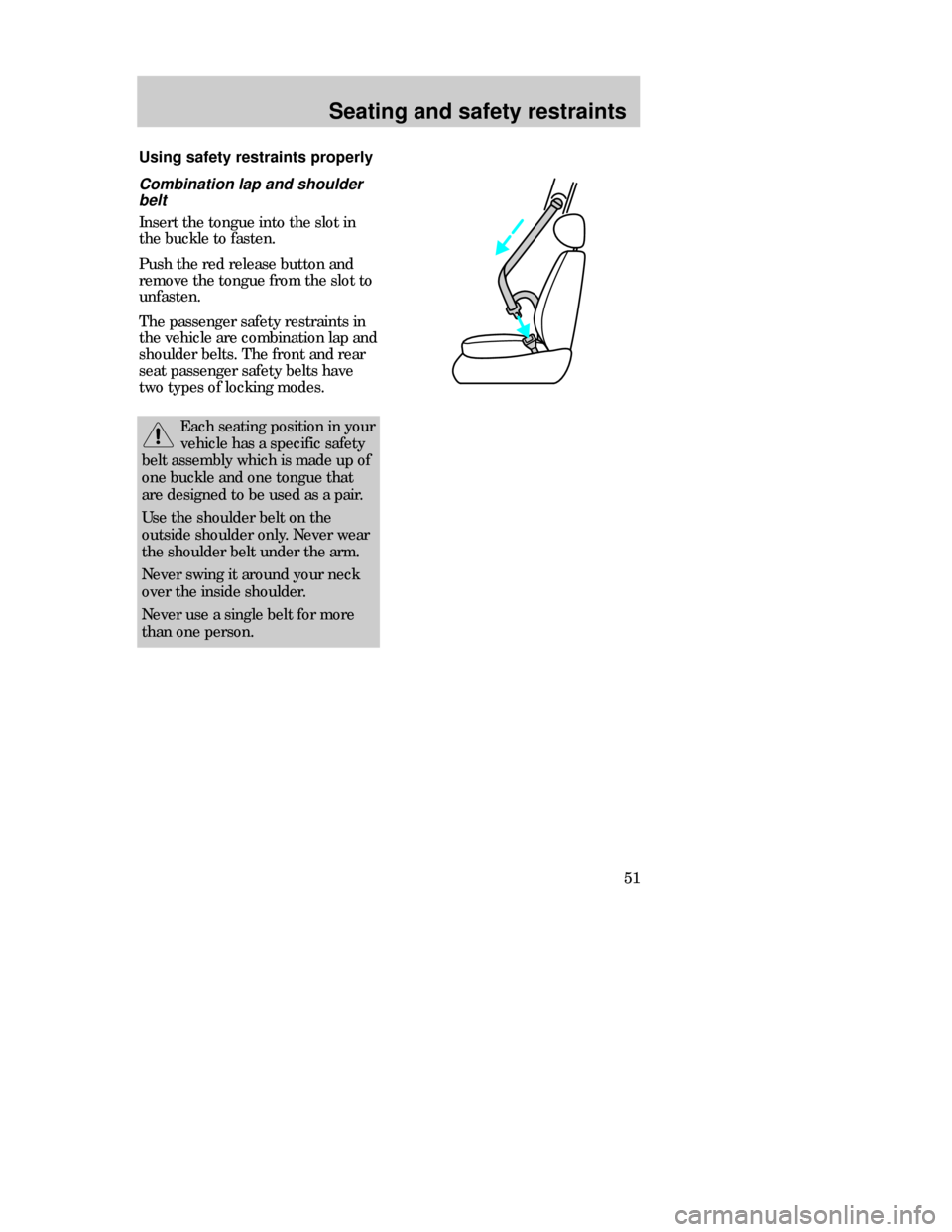
Seating and safety restraints
51
Combination lap and shoulder
belt
Insert the tongue into the slot in
the buckle to fasten.
Push the red release button and
remove the tongue from the slot to
unfasten.
The passenger safety restraints in
the vehicle are combination lap and
shoulder belts. The front and rear
seat passenger safety belts have
two types of locking modes.
Using safety restraints properly
Each seating position in your
vehicle has a specific safety
belt assembly which is made up of
one buckle and one tongue that
are designed to be used as a pair.
Use the shoulder belt on the
outside shoulder only. Never wear
the shoulder belt under the arm.
Never swing it around your neck
over the inside shoulder.
Never use a single belt for more
than one person.
CDW IIID Seat en C 5/15/97 8:48 PM Page 51
Page 52 of 200
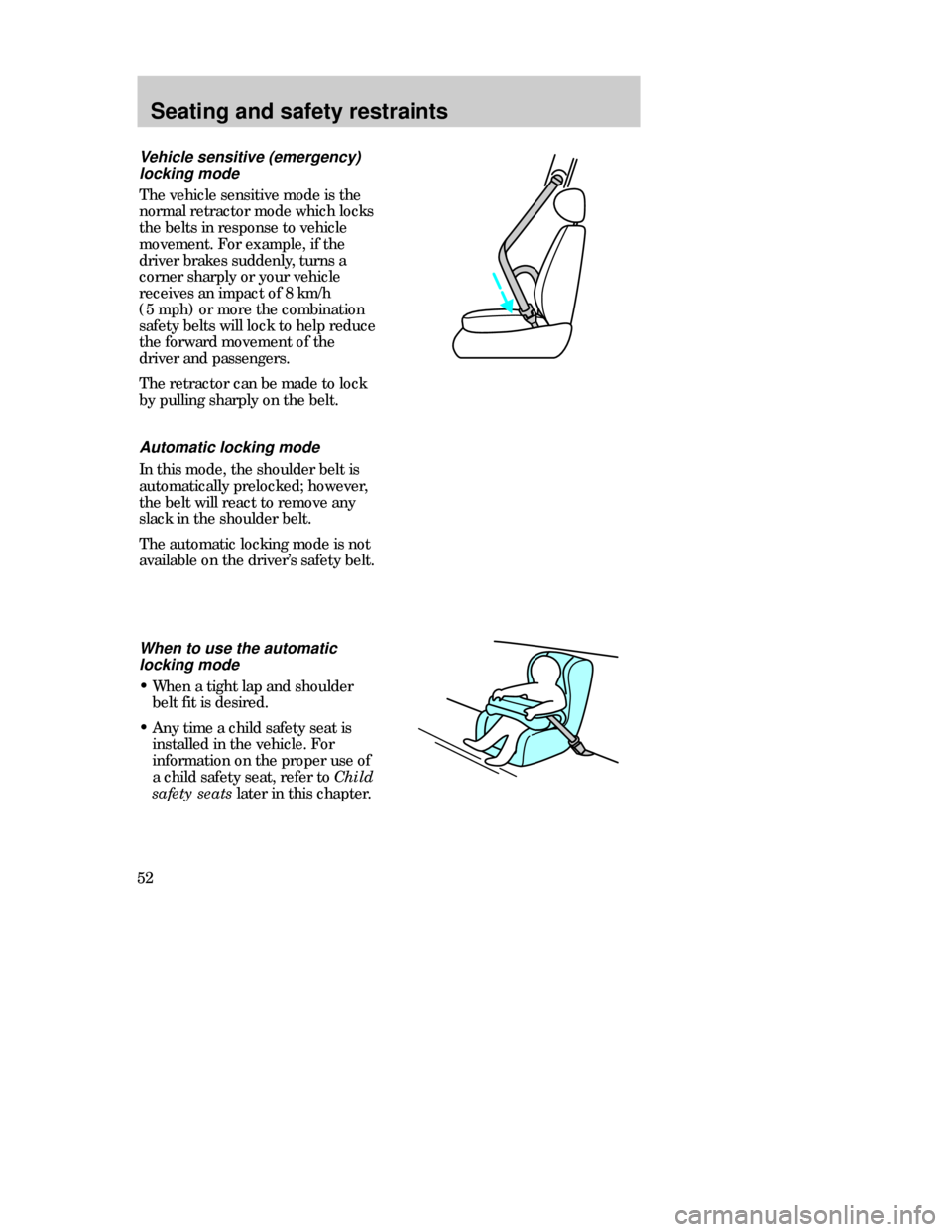
Seating and safety restraints
52
Automatic locking mode
In this mode, the shoulder belt is
automatically prelocked; however,
the belt will react to remove any
slack in the shoulder belt.
The automatic locking mode is not
available on the driver’s safety belt.
When to use the automatic
locking mode
•When a tight lap and shoulder
belt fit is desired.
•Any time a child safety seat is
installed in the vehicle. For
information on the proper use of
a child safety seat, refer to
Child
safety seatslater in this chapter.
Vehicle sensitive (emergency)
locking mode
The vehicle sensitive mode is the
normal retractor mode which locks
the belts in response to vehicle
movement. For example, if the
driver brakes suddenly, turns a
corner sharply or your vehicle
receives an impact of 8 km/h
(5mph) or more the combination
safety belts will lock to help reduce
the forward movement of the
driver and passengers.
The retractor can be made to lock
by pulling sharply on the belt.
CDW IIID Seat en C 5/15/97 8:48 PM Page 52
Page 53 of 200
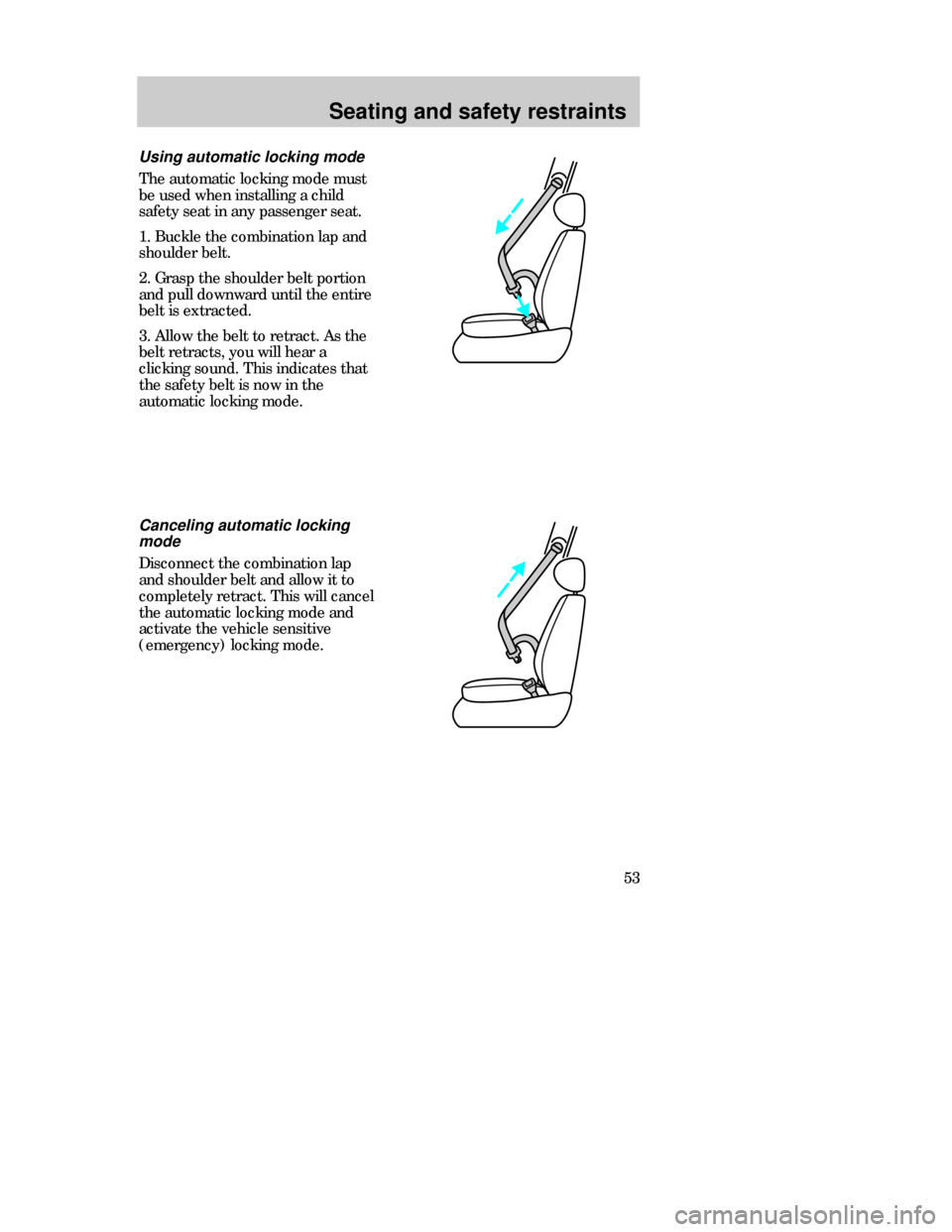
Seating and safety restraints
53
Using automatic locking mode
The automatic locking mode must
be used when installing a child
safety seat in any passenger seat.
1. Buckle the combination lap and
shoulder belt.
2. Grasp the shoulder belt portion
and pull downward until the entire
belt is extracted.
3. Allow the belt to retract. As the
belt retracts, you will hear a
clicking sound. This indicates that
the safety belt is now in the
automatic locking mode.
Canceling automatic locking
mode
Disconnect the combination lap
and shoulder belt and allow it to
completely retract. This will cancel
the automatic locking mode and
activate the vehicle sensitive
(emergency) locking mode.
CDW IIID Seat en C 5/15/97 8:48 PM Page 53
Page 54 of 200
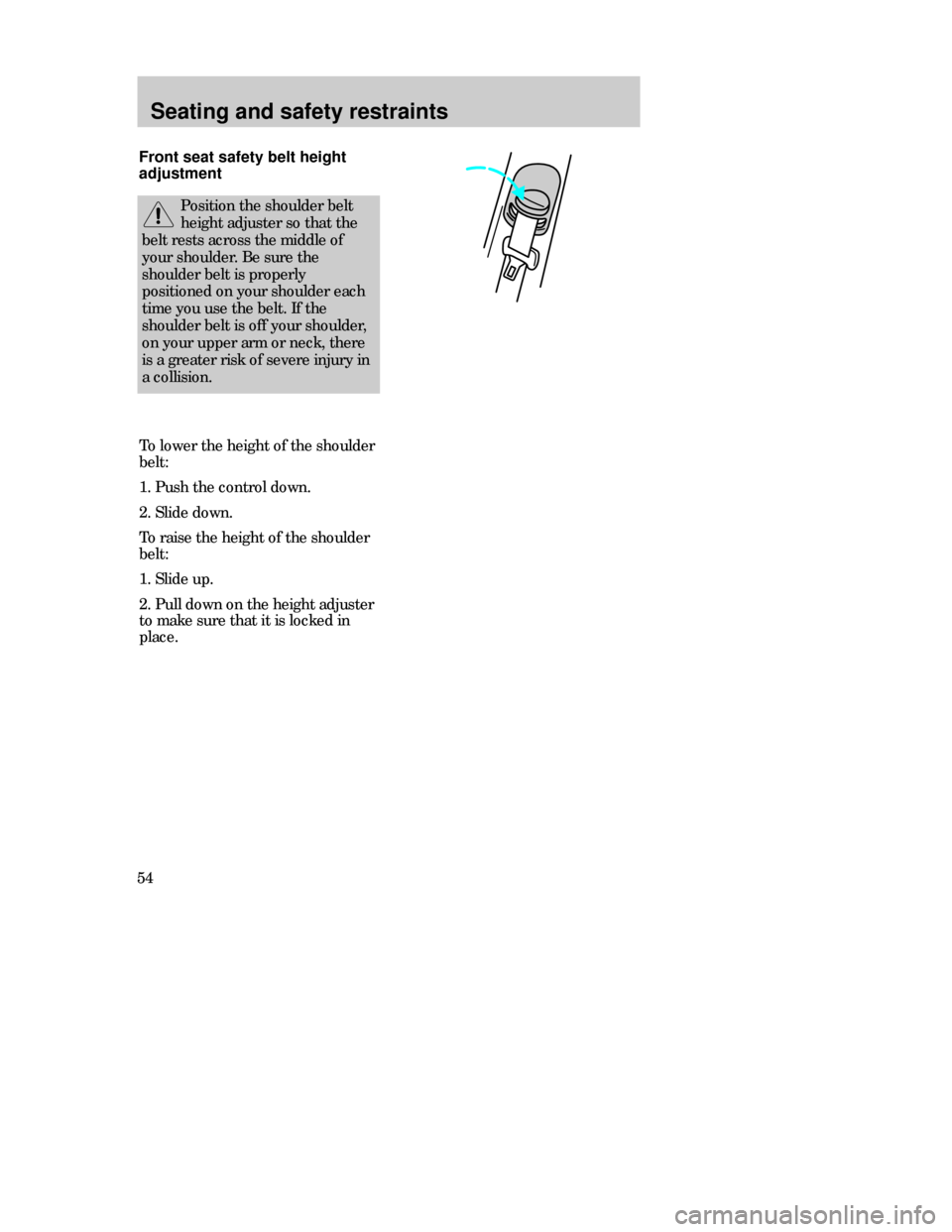
Seating and safety restraints
54
Front seat safety belt height
adjustment
To lower the height of the shoulder
belt:
1. Push the control down.
2. Slide down.
To raise the height of the shoulder
belt:
1. Slide up.
2. Pull down on the height adjuster
to make sure that it is locked in
place.
Position the shoulder belt
height adjuster so that the
belt rests across the middle of
your shoulder. Be sure the
shoulder belt is properly
positioned on your shoulder each
time you use the belt. If the
shoulder belt is off your shoulder,
on your upper arm or neck, there
is a greater risk of severe injury in
a collision.
CDW IIID Seat en C 5/15/97 8:48 PM Page 54
Page 55 of 200
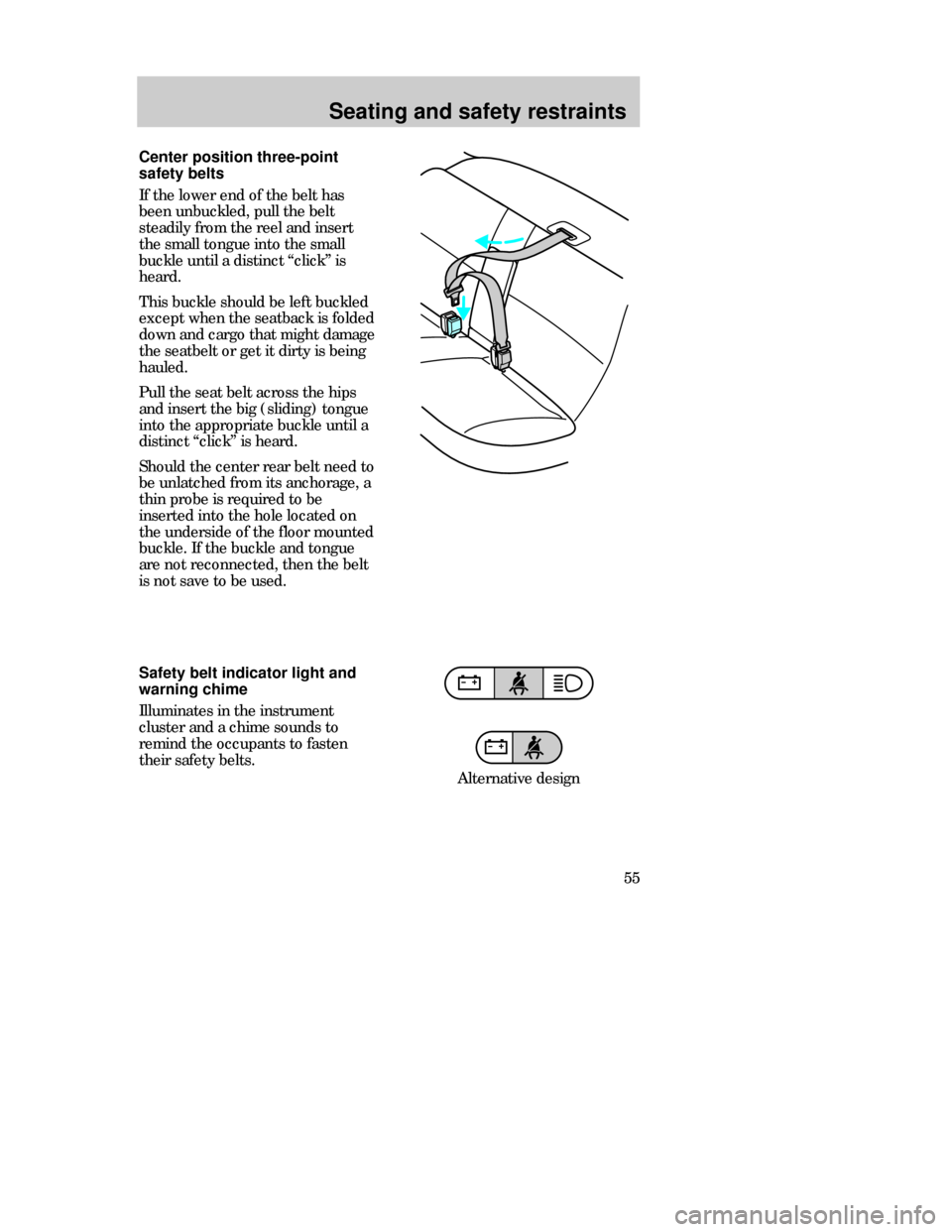
Seating and safety restraints
55 Safety belt indicator light and
warning chime
Illuminates in the instrument
cluster and a chime sounds to
remind the occupants to fasten
their safety belts.
Center position three-point
safety belts
If the lower end of the belt has
been unbuckled, pull the belt
steadily from the reel and insert
the small tongue into the small
buckle until a distinct “click” is
heard.
This buckle should be left buckled
except when the seatback is folded
down and cargo that might damage
the seatbelt or get it dirty is being
hauled.
Pull the seat belt across the hips
and insert the big (sliding) tongue
into the appropriate buckle until a
distinct “click” is heard.
Should the center rear belt need to
be unlatched from its anchorage, a
thin probe is required to be
inserted into the hole located on
the underside of the floor mounted
buckle. If the buckle and tongue
are not reconnected, then the belt
is not save to be used.
Alternative design
CDW IIID Seat en C 5/15/97 8:48 PM Page 55
Page 56 of 200
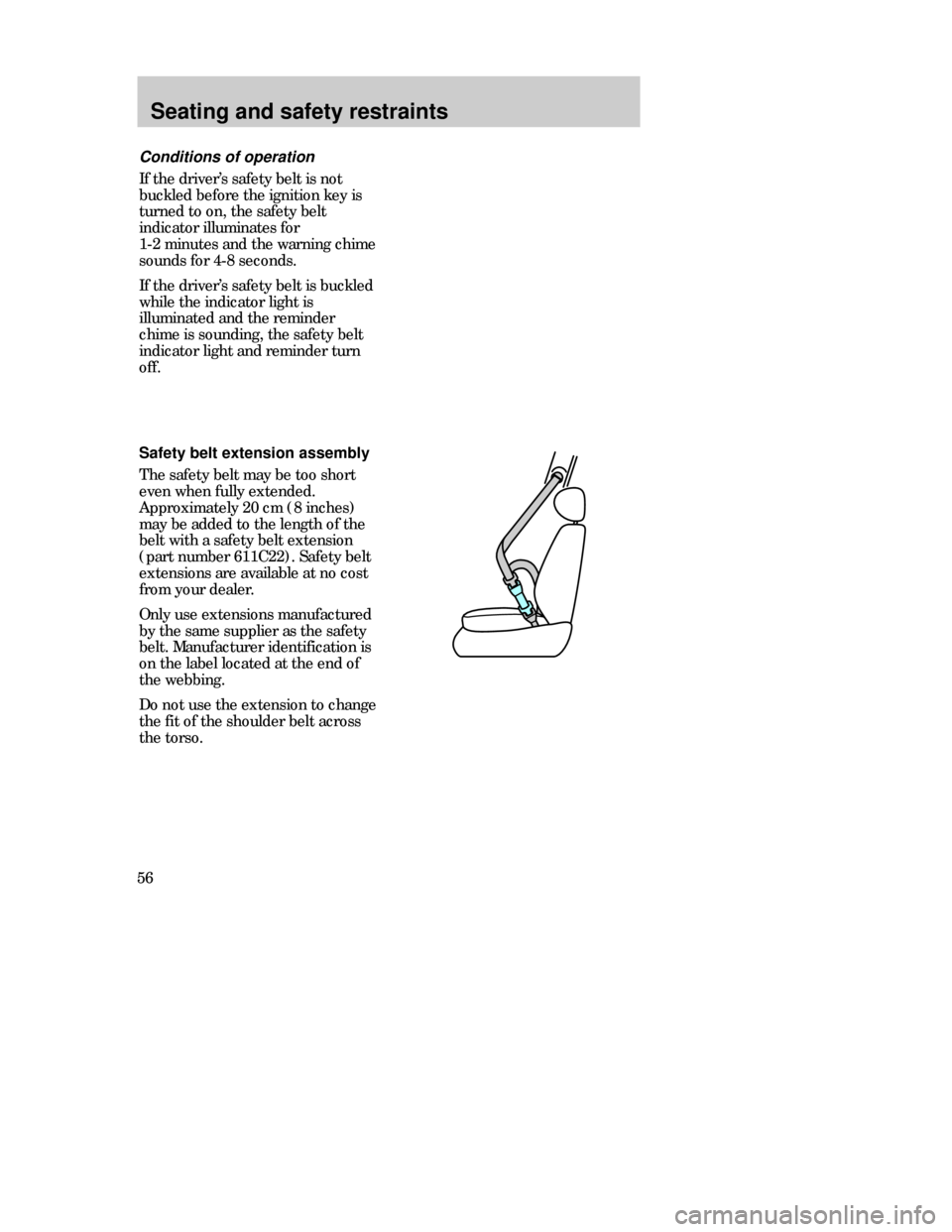
Seating and safety restraints
56
Conditions of operation
If the driver’s safety belt is not
buckled before the ignition key is
turned to on, the safety belt
indicator illuminates for
1-2 minutes and the warning chime
sounds for 4-8 seconds.
If the driver’s safety belt is buckled
while the indicator light is
illuminated and the reminder
chime is sounding, the safety belt
indicator light and reminder turn
off.
Safety belt extension assembly
The safety belt may be too short
even when fully extended.
Approximately 20 cm (8 inches)
may be added to the length of the
belt with a safety belt extension
(part number 611C22). Safety belt
extensions are available at no cost
from your dealer.
Only use extensions manufactured
by the same supplier as the safety
belt. Manufacturer identification is
on the label located at the end of
the webbing.
Do not use the extension to change
the fit of the shoulder belt across
the torso.
CDW IIID Seat en C 5/15/97 8:48 PM Page 56
Page 57 of 200
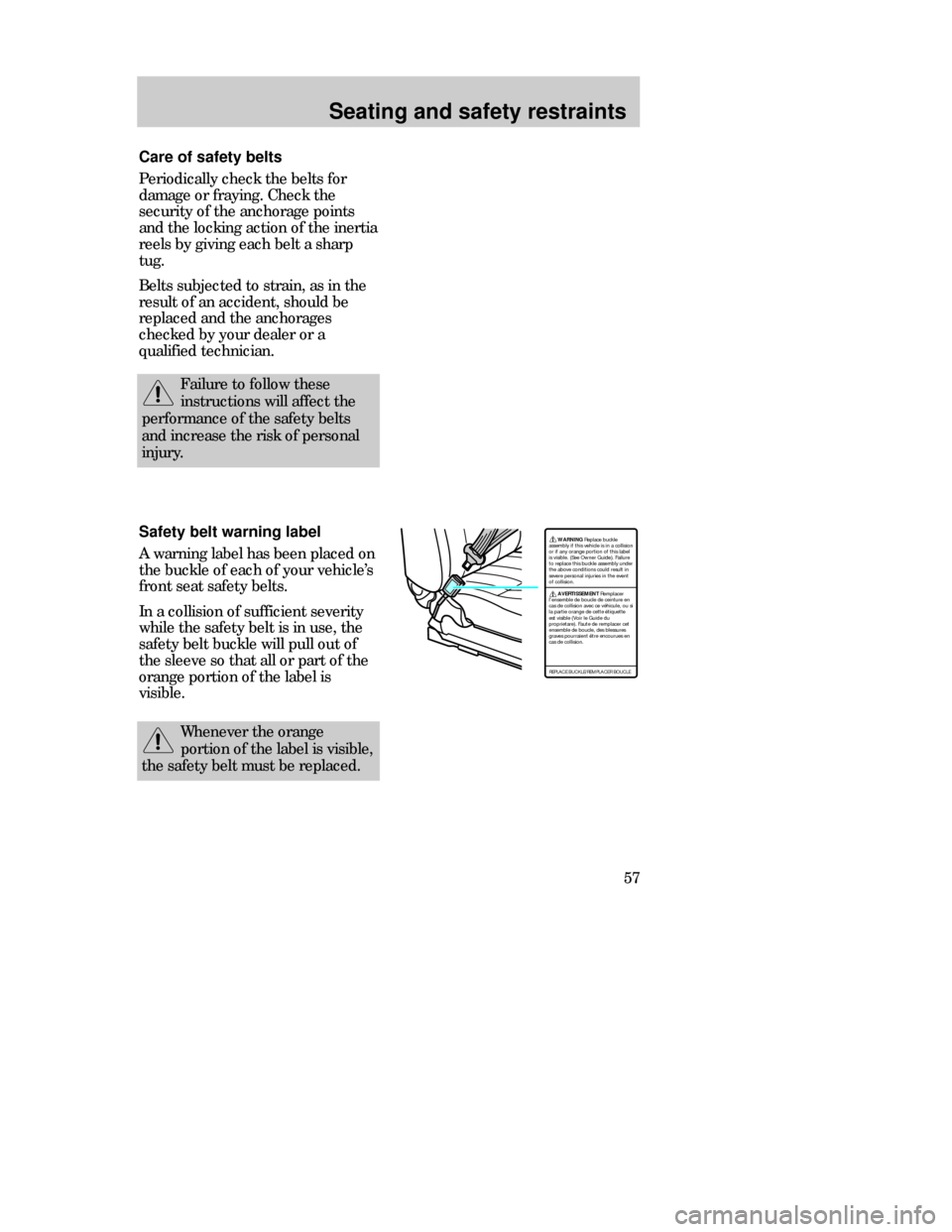
Seating and safety restraints
57 Care of safety belts
Periodically check the belts for
damage or fraying. Check the
security of the anchorage points
and the locking action of the inertia
reels by giving each belt a sharp
tug.
Belts subjected to strain, as in the
result of an accident, should be
replaced and the anchorages
checked by your dealer or a
qualified technician.
Failure to follow these
instructions will affect the
performance of the safety belts
and increase the risk of personal
injury.
Safety belt warning label
A warning label has been placed on
the buckle of each of your vehicle’s
front seat safety belts.
In a collision of sufficient severity
while the safety belt is in use, the
safety belt buckle will pull out of
the sleeve so that all or part of the
orange portion of the label is
visible.
Whenever the orange
portion of the label is visible,
the safety belt must be replaced.
WARNING Replace buckle
assembly if this vehicle is in a collision
or if any orange portion of this label
is visible. (See Owner Guide). Failure
to replace this buckle assembly under
the above conditions could result in
severe personal injuries in the event
of collision.
AVERTISSEMENT Remplacer
l'ensemble de boucle de ceinture en
cas de collision avec ce véhicule, ou si
la partie orange de cette étiquette
est visible (Voir le Guide du
proprietare). Faute de remplacer cet
ensemble de boucle, des blessures
graves pourraient être encourues en
cas de collision.
REPLACE BUCKLE/REMPLACER BOUCLE
CDW IIID Seat en C 5/15/97 8:48 PM Page 57
Page 58 of 200
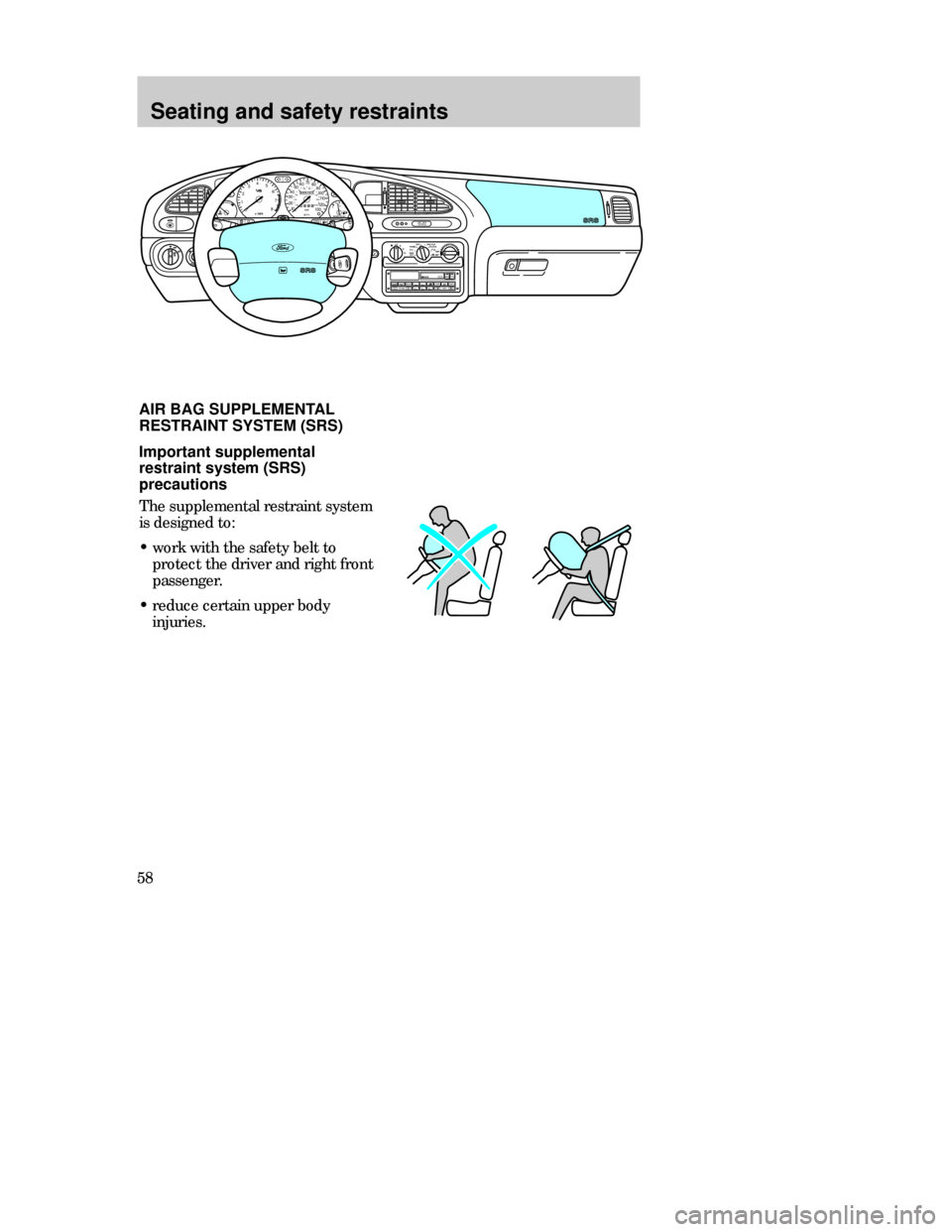
Seating and safety restraints
58Important supplemental
restraint system (SRS)
precautions
The supplemental restraint system
is designed to:
•work with the safety belt to
protect the driver and right front
passenger.
•reduce certain upper body
injuries.
AIR BAG SUPPLEMENTAL
RESTRAINT SYSTEM (SRS)
MIRRORS
HM:
I0 20
OFF LOPNL/FLR
PANEL
A/CFLOOR
DEF FLR
DEF
MAX
A/C HI/
POWERAUDIOAM/FM
SCAN
SEEK 312645ANSSIDE1-2EJECTVOLUME
000123000010 20 3040506070
80
90
100
110
120
130MPH20 406055
80120 100
140
160
180
200EF 1
/
2UNLEADED FUEL ONLY12
03x 1000
4
5
6
7
8
NORMALBRAKE
CHECK
ENGINE TRACTION
CONTROLO/D
OFF
CDW IIID Seat en C 5/15/97 8:48 PM Page 58
Page 59 of 200
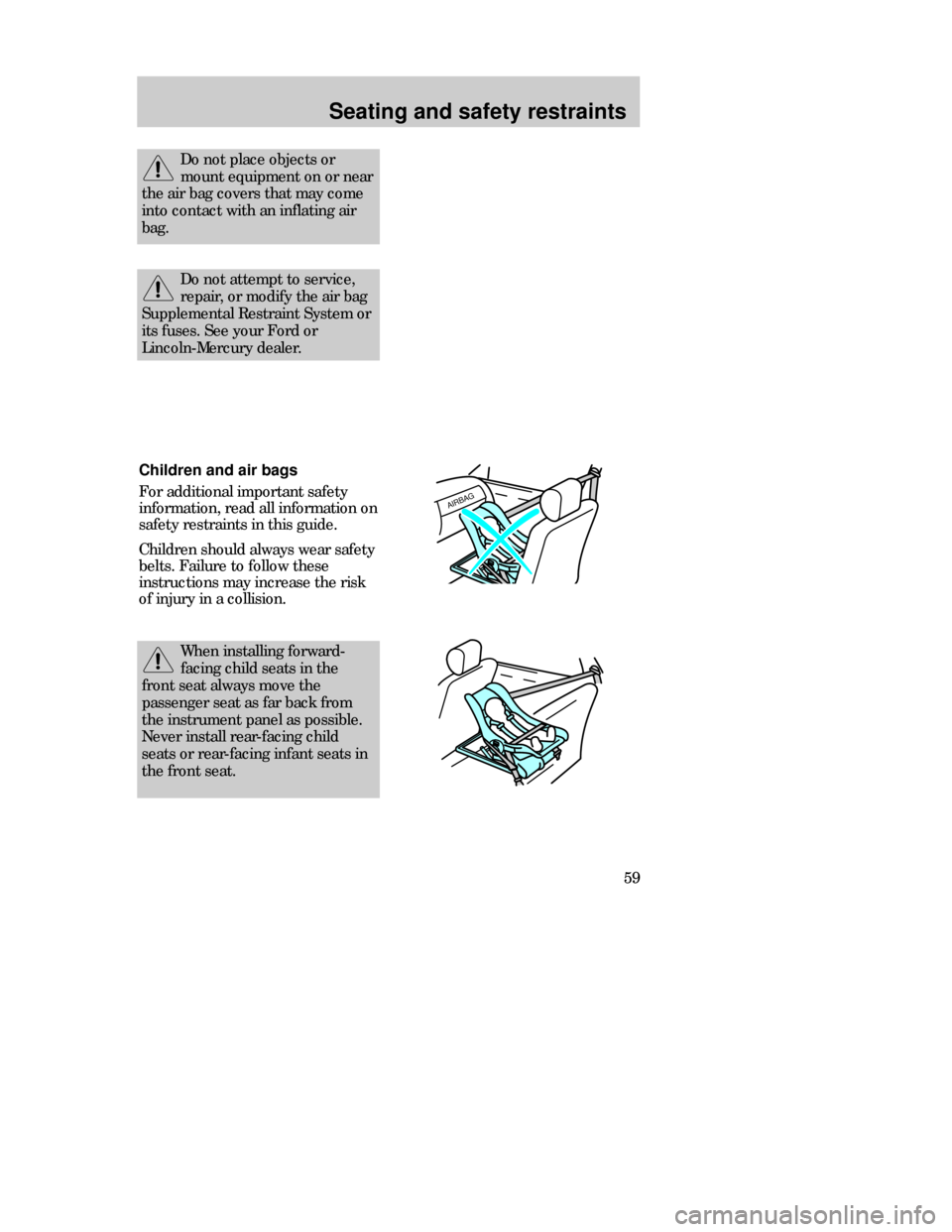
Seating and safety restraints
59
Do not attempt to service,
repair, or modify the air bag
Supplemental Restraint System or
its fuses. See your Ford or
Lincoln-Mercury dealer.
AIRBAG
When installing forward-
facing child seats in the
front seat always move the
passenger seat as far back from
the instrument panel as possible.
Never install rear-facing child
seats or rear-facing infant seats in
the front seat.
Children and air bags
For additional important safety
information, read all information on
safety restraints in this guide.
Children should always wear safety
belts. Failure to follow these
instructions may increase the risk
of injury in a collision.
Do not place objects or
mount equipment on or near
the air bag covers that may come
into contact with an inflating air
bag.
CDW IIID Seat en C 5/15/97 8:48 PM Page 59
Page 60 of 200
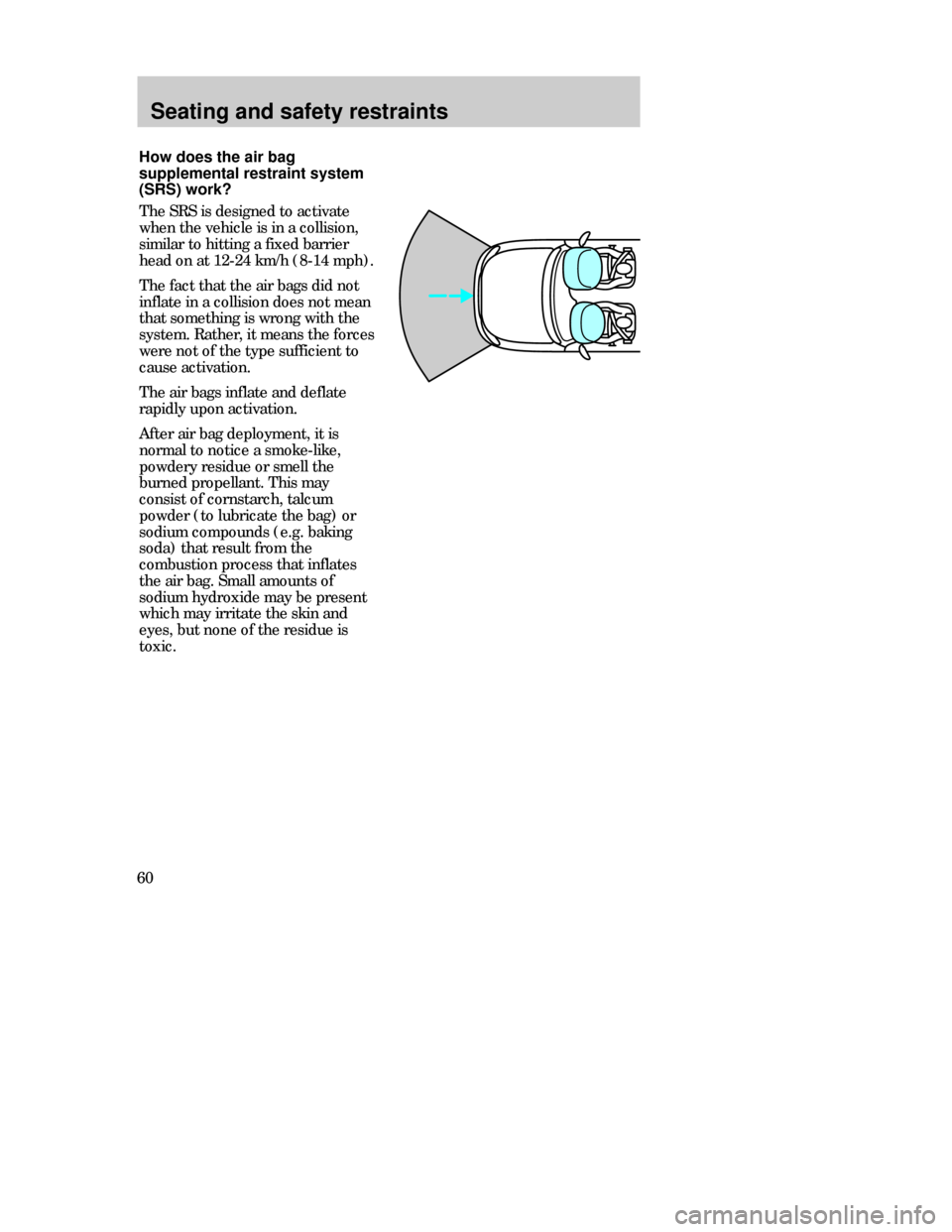
Seating and safety restraints
60
How does the air bag
supplemental restraint system
(SRS) work?
The SRS is designed to activate
when the vehicle is in a collision,
similar to hitting a fixed barrier
head on at 12-24 km/h (8-14 mph).
The fact that the air bags did not
inflate in a collision does not mean
that something is wrong with the
system. Rather, it means the forces
were not of the type sufficient to
cause activation.
The air bags inflate and deflate
rapidly upon activation.
After air bag deployment, it is
normal to notice a smoke-like,
powdery residue or smell the
burned propellant. This may
consist of cornstarch, talcum
powder (to lubricate the bag) or
sodium compounds (e.g. baking
soda) that result from the
combustion process that inflates
the air bag. Small amounts of
sodium hydroxide may be present
which may irritate the skin and
eyes, but none of the residue is
toxic.
CDW IIID Seat en C 5/15/97 8:48 PM Page 60